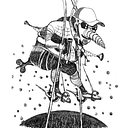by Vas Mylko
The smartest itinerary and route optimization AI must have the best look. We didn’t want to go with photos of the points and places because all travel websites use them and don’t differ from each other. We wanted Curiosio to stand out. The idea was to visualize the points and places with artists who learn about or even visit the place and feel it, and represent the feelings in the drawings, noticing and hyperbolizing certain facets of the place.
We want to produce visuals of the points and places in our own multi-facet digital curious style. Visually it resembles Paper Architecture by Brodsky & Utkin. They drew together on big sheets of paper. The scan/photo below is too dark in comparison to the real artwork; I saw them at Tate in London.
Sapiens
Originally, the specific idea for the visual side of Curiosio came from the Château Mouton Rothschild wine labels initiative and tradition. The famous artists tasted the crus and painted the meaning and feeling as the wine labels. We conceptualized our Una Curiosità style and brand. We ran artistic experiments, trying to measure the productivity, quality, scalability, and cost estimate of this mega-ambitious effort. Sapiens failed.
Sapiens artists failed because of the slow pace, long face-to-face conversations-explanations of the curious facets of the place, hardly possible iterations of the same concept (because it’s a new drawing on paper each time), and high cost (per artwork). Digitization of the assets needs time and a whole custom content management system. But what worked was beautiful, even unfinished, even low-light low-contrast blurred photos of the artworks are beautiful. Alas, didn’t take off.
Machines
Ciao humans. But we are not giving up. We are cutting-edge technologists and programmers. With the advances in AI—Language Models and Generative Image Models — we decided to try again. Below are the results of two experiments: the first with a visualization of an interesting city, and the second is a visualization of an interesting place. The city is Rome, the place is its Pantheon. The artist is me and Stable Diffusion.
ROME
Italy was the first country where Curiosio technology was ever unlocked. Rome is the capital of Italy. All Roads Lead to Rome, that’s why Rome. Below is a candidate for the main facet of a composite visual of Rome.
Isn’t Rome on the horizon? Isn’t it a Roman road that defined the size of a space rocket? It’s metaphorical, hyperbolical, deep, visceral, and beautiful.
ROMAN PANTHEON
Here is a candidate visualization as the main facet for the composite image of the Pantheon in Rome. The runner-up facet and extra facets are not shown yet.
Here is a potential composite image of the Pantheon in Rome. It could be dynamic, with dynamically morphing extra facets on the left.
Machines and generative AI are good enough. Not ideal, not super-fast, I’d even say that resolution 1024x1024 on laptop hardware (GeForce 3050 4GB) is excruciatingly slow. The relevancy and quality of the art are not stable enough. But together with a human semi-artist, machines may succeed.
Sapiens and Machines
Morphing images are possible. Micro-animation is possible. The main facet could be animated like these Japanese woodcuts. Why not make this tiny tightrope walker [see below] indeed walk the rope? Seems like a human artist will be still needed for such creative surgical intervention. While the artwork at the scale that we want could be done by machines and AI.
